American
Whiskey:
April
29,
2011
--
Tennessee
Whiskey
Country
Phil Prichard points out that he has to emphasize "legal" because there may be a distillery "out there in the hills somewhere" that could be larger! |
The motto on the Prichard family coat of arms translates as "You Will Have To Break Me Before I Yield". At first glance, that might seem to be a boast of stubbornness or obstinacy. Or maybe just perseverance and courage, which are better ways to describe Phil Prichard's personality. But the horse's head is what tells the real story. This is not a horse that belongs to some famous general or warrior prince. This is a gentle horse, My Little Pony, a de-horned unicorn. The motto doesn't mean "I will never surrender"; it says, in terms that any horse owner would understand, "I will be your friend, but only after you've established yourself as my leader."
Horses are important around here. Shelbyville, where we are
staying, is only about thirty miles away, and it is the center of Tennessee's
horse country. The horses
we see are not Thoroughbred racing horses, though, like
what you'll find in Kentucky's horse country. They
are Tennessee Walking Horses, a recognized breed of their own. They are not bred
for racing; their purpose is to provide comfortable, and highly fashionable,
equine transportation. They are famous for their spirited, high-stepping strut.
According to Oklahoma State University, the most prominent characteristic
of Tennessee Walkers is "... their swift and smooth 'running walk.' This gait
is inherited and cannot be taught to a horse who does not possess it naturally.
It is a square four-beat gait with a gliding motion, and a bobbing of the
head and swinging of the ears accompany each step. Some Walkers are even
known to snap their teeth in time. When performing the running walk, these
horses will overstride, placing the back hoof ahead of their forehoof print.
Traveling at speeds from 6 to 12 miles per hour, Walkers can sustain this
gait for long distances without fatigue to themselves or their passengers."
The horses
we see are not Thoroughbred racing horses, though, like
what you'll find in Kentucky's horse country. They
are Tennessee Walking Horses, a recognized breed of their own. They are not bred
for racing; their purpose is to provide comfortable, and highly fashionable,
equine transportation. They are famous for their spirited, high-stepping strut.
According to Oklahoma State University, the most prominent characteristic
of Tennessee Walkers is "... their swift and smooth 'running walk.' This gait
is inherited and cannot be taught to a horse who does not possess it naturally.
It is a square four-beat gait with a gliding motion, and a bobbing of the
head and swinging of the ears accompany each step. Some Walkers are even
known to snap their teeth in time. When performing the running walk, these
horses will overstride, placing the back hoof ahead of their forehoof print.
Traveling at speeds from 6 to 12 miles per hour, Walkers can sustain this
gait for long distances without fatigue to themselves or their passengers."
Clearly, if these horses were rum or whiskey, they would be sippin' rum or whiskey, not just head-bangers' juice.
Welcome to
Phil Prichard's distillery. We've met Phil a
few times during the last half-dozen years, but this is the first chance we've
had to visit his distillery in Kelso, Tennessee, and spend some quality one-on-one time with
him.
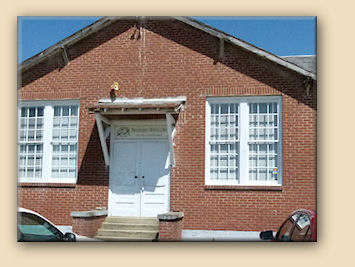
We arrive at the school on a beautiful, sunshiny afternoon in late April.
Did we say, "school"? Yes; the distillery occupies a brick building that had been Kelso's schoolhouse for forty years until 1979, and was still being used as the Community Center when Prichard began distilling there in 1999. For the first couple of years, he was only renting out a portion of the building; Saturday night dances were still being held in the gym.
In 2002 Prichard bought the whole building and began
moving in. But unlike most businesses, he didn't strip everything out and build
all-new offices, facilities and a fancy faux-antique visitor center and tasting
bar. The last class taught at the school was in 1979, and the chalkboards and
wall maps are still on the walls... and in use. The enameled-steel teacher's
desk is now occupied by the chief executive officer. It is nearly buried in sample
bottles and clutter. Another old table supports the company's computer and
printing technology. Bottling is handled in another of the old classrooms, as is
the tasting room and visitor's facility. The distillery equipment resides in a
detached building that probably once served as the maintenance department, and
barrel storage is in another detached shed.
 The shipping department and packaged
goods storage is in the old gym. The basketball hoops remain, along with the
Kelso Community Center banner and some old stage lighting from the dances.
The shipping department and packaged
goods storage is in the old gym. The basketball hoops remain, along with the
Kelso Community Center banner and some old stage lighting from the dances.
We arrive and are greeted by Phil and his son, Seth. Seth is vice president of production, which, in an organization of this size means he gets to do just about everything that gets done here, from building maintenance to production, bottling, labeling, packaging, and... well, the list goes on and on. This afternoon he is showing John and Linda around. We start, as do nearly all such tours, with a brief history. But this one isn't a DVD film presentation, just Seth telling us about it. And he should know; he's been here from the start.
Distilling has been a part of the Prichard family for a
long time, but there's been a pretty big gap in that time. Benjamin Prichard,
of Davidson County, Tennessee, is the namesake for the current label. It was his
legal will and testament -- leaving all his distillery equipment to his son
Enoch -- that provides documentation for the last known legal distiller in the
Prichard family. That was five generations ago. Presumably, Enoch did not
continue the business, nor did anyone else in the family until Philip Prichard
decided he'd like to make some rum, back in 1993. It was a hobby then; Phil's
father was a dentist and Phil had worked as a dental technician for thirty
years. He commandeered his wife's canning pot one afternoon, made a few
modifications, and began producing home-made rum. That was before he found out
it was illegal, even as a hobby.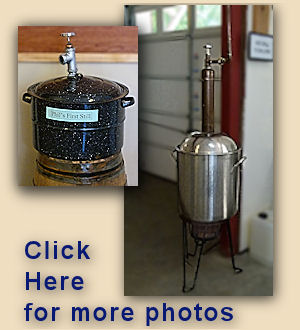 So he applied to the ATF for a distiller's
permit and then discovered that, except for matters of scale, it isn't a whole
lot much more expensive or troublesome to operate a commercial distillery than
to make rum at home in your spare time -- and so Prichard's Distillery was born in
1997.
So he applied to the ATF for a distiller's
permit and then discovered that, except for matters of scale, it isn't a whole
lot much more expensive or troublesome to operate a commercial distillery than
to make rum at home in your spare time -- and so Prichard's Distillery was born in
1997.
His original still, the one his wife used to can fruits in, is on display here. So is his second one, which is actually used occasionally for extremely small batches. It's also used sometimes for its original purpose, which is as a gas-fired turkey deep-fryer. They just detach the stainless steel mixing bowl that serves as the still cap and they're ready to party. Noting that Jones Soda, a boutique soft drink company, is notorious for their seasonal Thanksgiving Dinner flavor, a combination of cranberry and roast turkey flavors (but fizzy!), we facetiously suggest they might try doing that with rum. Seth says he strongly doubts they'll be trying that one.
Not that there's any lack of variety in their products. They actually do make a cranberry rum (no turkey, though). Also a key-lime rum, a peach-mango rum, a crystal-clear white rum suitable for drinking straight or on ice, without mixers, and a "fine" rum, which should be taken straight, without mixers. All of these have won numerous gold and silver medals, "best-in-show" citations, and other awards. Phil's come a long way from his old hobby days.
Prichard's also produces a "private stock" bottling of their finest rum, which has been aged in new charred oak barrels. There isn't enough of this to go out to distributors; the only source is at the distillery. Needless to say, we now own a couple bottles. Well, somewhat less than a couple bottles, now. It is among the finest rums we've ever tasted.
So why rum? I mean, aren't these pages all about American
WHISKEY? No, they started out that way a dozen years ago, but we've
learned much more about American spirits since then. And one of the most
interesting has been how important rum was. Whiskey was really not an important
part of Colonial America at all, at least not in the civilized parts. Out on the
frontier -- that is, west of the Appalachian mountains -- whiskey was very
common. But that whiskey was not the type of aged spirit we've come to expect.
It was nearly always a white spirit, called "whiskey" even though it was
invariably made from either mostly corn or rye, rather than the malted barley
that "real" whisky would have been made of, were that available. It served many
purposes besides just as an intoxicant; it was used medically, industrially, and
in many other ways. Perhaps more importantly, it was also used as money. Whiskey
could be created directly from farm produce, and then deposited or sold to
merchants who would store the whiskey and eventually send it back across the
mountains or down the rivers to markets where it would bring high prices... but
not necessarily as whiskey. In those exciting days before labeling laws,
reddish-brown, aged whiskey from Western Pennsylvania (perhaps called simply
Monongahela, without specifying what kind of spirit it was) may well have been
sold as a type of rum in the eastern markets, especially after the Triangle
Trade with Africa ended and independence from England put the British Caribbean
colonies out of touch. 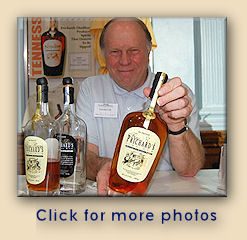
Prichard's makes whiskey, too. Good whiskey. And, typical of everything that interests Phil Prichard enough for him to actually want to be involved with it, his whiskies are unique, historic, and very controversial. Three perfect examples are...
 Prichard's Single Malt Whiskey is made from 100% barley in
the Irish tradition, that is, using both malted and unmalted barley and
distilled (like all of Prichard's spirits) in their beautiful all-copper pot
stills (no residual turkey flavor here). It has won numerous rewards in every
competition they've entered it in.
Prichard's Single Malt Whiskey is made from 100% barley in
the Irish tradition, that is, using both malted and unmalted barley and
distilled (like all of Prichard's spirits) in their beautiful all-copper pot
stills (no residual turkey flavor here). It has won numerous rewards in every
competition they've entered it in.
Prichard's Double-Barreled Bourbon. Phil doesn't make this
whiskey originally. The whiskey he makes (see Prichard's Tennessee Whiskey,
below) is already produced to his high (and historical) quality standards.
Phil's contention is that American bourbon generally isn't anymore. And he is
correct.
 After Prohibition ended in 1934, the federal regulations required that
bourbon (and all whiskey) be put into the barrel at a proof no higher than 110°
(55% ABV), although most distillers kept closer to 100 proof. In 1962, industry
pressure succeeded in getting that regulation altered to allow barreling proof
as high as 125°. American distilleries today (at least the majors) almost
universally barrel their products at that proof. Why? Because it's a lot
cheaper. More alcohol per barrel means less barrels for the same output. It also
affects the taxes being paid. Unfortunately, it also affects the way the
resultant aged whiskey will taste. For one thing, a 62.5% alcohol solution
extracts flavor elements from a new, charred oak barrel differently from how a
55% (or 50%) solution does.
After Prohibition ended in 1934, the federal regulations required that
bourbon (and all whiskey) be put into the barrel at a proof no higher than 110°
(55% ABV), although most distillers kept closer to 100 proof. In 1962, industry
pressure succeeded in getting that regulation altered to allow barreling proof
as high as 125°. American distilleries today (at least the majors) almost
universally barrel their products at that proof. Why? Because it's a lot
cheaper. More alcohol per barrel means less barrels for the same output. It also
affects the taxes being paid. Unfortunately, it also affects the way the
resultant aged whiskey will taste. For one thing, a 62.5% alcohol solution
extracts flavor elements from a new, charred oak barrel differently from how a
55% (or 50%) solution does.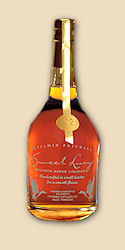 Noticeably differently. For another, reducing a 125
proof whiskey to a bottling strength of, say, 90 proof involves diluting it with
a lot more water than reducing a 100 proof whiskey. Prichard's has regular
Kentucky bourbon (he won't say whose; it probably doesn't matter), which was
barreled at 125 proof and aged for 9 years, dumped, brought down to 90 proof, and then
re-barreled -- in new charred oak barrels -- and then re-aged
for another 3 to 5 years.
He then bottles it just the way it comes from the second barreling. The result
isn't exactly the same as distilling it out at low proof and barreling it that
way to begin with (that's what Phil does with his Tennessee whiskey that he makes
from scratch), but it's a big improvement. It's also an expensive one, and he
probably wouldn't have continued after his experiment, except that it won lots
of awards, was featured prominently in Jim Murray's 1999 Whiskey Bible, and
developed a strong demand from consumers, despite it's (obviously necessary)
relatively high price.
Noticeably differently. For another, reducing a 125
proof whiskey to a bottling strength of, say, 90 proof involves diluting it with
a lot more water than reducing a 100 proof whiskey. Prichard's has regular
Kentucky bourbon (he won't say whose; it probably doesn't matter), which was
barreled at 125 proof and aged for 9 years, dumped, brought down to 90 proof, and then
re-barreled -- in new charred oak barrels -- and then re-aged
for another 3 to 5 years.
He then bottles it just the way it comes from the second barreling. The result
isn't exactly the same as distilling it out at low proof and barreling it that
way to begin with (that's what Phil does with his Tennessee whiskey that he makes
from scratch), but it's a big improvement. It's also an expensive one, and he
probably wouldn't have continued after his experiment, except that it won lots
of awards, was featured prominently in Jim Murray's 1999 Whiskey Bible, and
developed a strong demand from consumers, despite it's (obviously necessary)
relatively high price.
Prichard's Sweet Lucy. This is a bourbon-based liqueur
flavored with peaches, oranges, and apricots. Once upon a time, there was a very
well-known and widely-appreciated product which was, shall we say, comfortably
southern in flavor. Such a product still exists, but in name only. Prichard's
Sweet Lucy is the real deal. It is also Prichard's number one best seller among
bourbon products. One taste and you'll understand why.
And then we have Prichard's Tennessee Whiskey. This whiskey, made from
sweet Tennessee white corn milled just a few miles away at the historic Falls
Mill in Belevedere, is
probably the most controversial of all Phil's whiskies. In fact, among American
spirits aficionados this could be a real paradigm-breaker. You see, it started
with a fellow (right here in Tennessee, as a matter of fact) named Reagor Motlow.
 Does that name, Motlow, ring a bell? It should. Reagor was the son of Lem Motlow,
the celebrated "Proprietor" of the Jack Daniel brand of Tennessee Whiskey. Many
people, including some who should know better, believe that Jack Daniel's
whiskey is bourbon. It's not. And the reason it's not (along with whether that
reason is valid) is the subject of an enormous amount of bar-room (and internet
forum) debate. Two facts that should be kept in mind, though, are (1) no Jack
Daniel's label has ever used the word "bourbon" (or even "straight whiskey") on
it, and (2) there is not, nor has there ever been, a legal definition of
"Tennessee whiskey".
Does that name, Motlow, ring a bell? It should. Reagor was the son of Lem Motlow,
the celebrated "Proprietor" of the Jack Daniel brand of Tennessee Whiskey. Many
people, including some who should know better, believe that Jack Daniel's
whiskey is bourbon. It's not. And the reason it's not (along with whether that
reason is valid) is the subject of an enormous amount of bar-room (and internet
forum) debate. Two facts that should be kept in mind, though, are (1) no Jack
Daniel's label has ever used the word "bourbon" (or even "straight whiskey") on
it, and (2) there is not, nor has there ever been, a legal definition of
"Tennessee whiskey".
In 1941, Reagor Motlow, then the president of the Jack
Daniel's company, petitioned the United States Treasury Department to
differentiate whiskey made by their particular method from "bourbon", which was
not on their label and which they did not wish to be associated with. They were,
in effect, unsuccessful, in that, while the Treasury Department agreed that
their whiskey was something other than "bourbon", it did not find it to be
particularly "special".
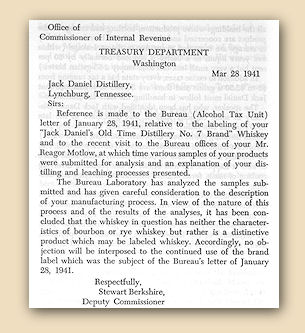 The government sent to Motlow a letter stating that the
spirit marketed by Jack Daniel's could "be labeled whiskey", which technically
put them into the same category as the cheapest non-blended whiskeys. Motlow,
unsung marketing genius that we consider him to be, then used that letter as the
basis for his claim that Jack Daniel's was a "special kind of whiskey". And,
since the Jack Daniel's distillery was also the only one registered in
Tennessee, he defined, on his label and in his advertising, Jack Daniel's as
"Tennessee Whiskey". He also made it clear that what made Tennessee whiskey
different from bourbon was the process of leaching the fusal oils from the
distillate by means of maple charcoal filtration, prior to barreling. Since the
Jack Daniel distillery was in Lincoln County at the time (the location later
became part of Moore County), it was called the Lincoln County Process.
The government sent to Motlow a letter stating that the
spirit marketed by Jack Daniel's could "be labeled whiskey", which technically
put them into the same category as the cheapest non-blended whiskeys. Motlow,
unsung marketing genius that we consider him to be, then used that letter as the
basis for his claim that Jack Daniel's was a "special kind of whiskey". And,
since the Jack Daniel's distillery was also the only one registered in
Tennessee, he defined, on his label and in his advertising, Jack Daniel's as
"Tennessee Whiskey". He also made it clear that what made Tennessee whiskey
different from bourbon was the process of leaching the fusal oils from the
distillate by means of maple charcoal filtration, prior to barreling. Since the
Jack Daniel distillery was in Lincoln County at the time (the location later
became part of Moore County), it was called the Lincoln County Process.
The facts are just a bit different, of course (they always seems to be, when examining spirits marketers' claims). There was nothing unique about the process Motlow described as originating in Lincoln County. In fact, according to President William Taft's overturning of some of the more restrictive 1906 Pure Food & Drug Act provisions, the method of using charcoal filtration to remove undesirable fusal oils from new-make whiskey was not only common, it was the method of choice for 75% of the producers of American whiskey in the early 1900s. Jack Daniel's -- as well as many other brands now touting themselves as "straight whiskey" -- was likely a rectified whiskey in those early days. And the maple-charcoal-filtration process most likely did make it a better-tasting product than its competitors.
There was nothing special, or "Tennessee" about the so-called Lincoln County process. But the belief was given added credibility many years later when Schenley rebuilt the Cascade Hollow distillery near Normandy and began producing George Dickel, the only other Tennessee whiskey at the time. Despite the fact that they could have made an argument for the maple leaching step being called the Coffee County Process, they were content to simply duplicate it and allow that idea as the definition of Tennessee whiskey to remain in the consumers' minds.
The effect of all this has been to make this maple-leaching step definitive of Tennessee whiskey. The fact is that there is no definitive Tennessee whiskey, and there never was. While it's true that there may be a discernable difference between the two best-known Tennessee whiskies and bourbons, there is at least that much difference between themselves. They don't taste alike; and there is nothing they have in common that distinguishes them, as a type, from whiskies called "bourbon".
But the real kicker is that Phil Prichard is producing whiskey, in Tennessee, that does not make use of that maple-charcoal-leaching process. So does that mean he isn't making Tennessee whiskey? Well how about this... Kelso is located in Lincoln County. Since Prichard's is the only Tennessee whiskey being made in Lincoln County, and Prichard's does not use a maple-charcoal-leaching step in their production, wouldn't that mean that the so-called "Lincoln County Process" would require that such a step NOT be used? Oh boy, we love these sort of complications!

Phil produces two brands of Tennessee whiskey, by
the way.
In addition to the aged product, he also has an unaged white corn whiskey he
calls "Lincoln County Lightning".
Maybe just to rub it in a little.
Of course, John can't help but note that, if one were to start
up a company in Boston, Massachusetts that canned and sold Campbell's- or
Heinz-style tomato sauce-based
pork 'n' baked beans, would they then be Boston Baked Beans just because they were made
there? Who knows? But it does make you think, doesn't it?
Phil Prichard is a man who thinks. While we are here,
exchanging tastes of some old and rare whiskies we'd brought and some unreleased
and equally rare spirits Phil went and found to share, he pours us a sample of
a wonderful spirit, the one that started it all for him. You see, there is an
historic basis for distilling rum in Tennessee, especially in way southern
Tennessee -- only a few miles from Alabama. Rum has been made here (illegally, of course) for
generations, but the "rum" is made, not from cane sugar or molasses, but from
sorghum. Sorghum is a grass which produces a sweet sap, and that sap is often made into
syrup and used much like molasses. That is, it's great on pancakes. But it also
makes a great base for producing rum. It was (and perhaps still is, although not
by licensed distilleries) the material of choice for such spirits throughout the
states just north of the gulf states. But when the federal code of regulations
defined distilled spirits at the end of Prohibition, the only material they
allowed for "rum" was sugar cane and its by-products. Okay, but they then
totally ignored sorghum and left it out of every spirit definition. Phil used to
make sorghum rum. In fact, because of its historic importance, and the fact that
sorghum can be obtained locally, while sugar molasses has to be brought in from
Louisiana, it was his spirit of choice. That was back before he found out about
the need for licensing. Now he can't make it anymore. But he still has a little.
It's on display in a cabinet in the visitor's center. And he brought it out for
us to taste.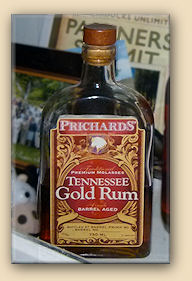
You know, there is nothing that tastes better than something that doesn't exist anymore. Or something illegal. Or something so special that you just know you'll never taste it again. That is how Prichard's Premium Molasses Tennessee Gold Rum tasted to us when he poured a sample. Oh, why can't he be allowed to market this product? Of course, even if he did it wouldn't be the same as this sample... this is what he distilled from his wife's canning kettle!
Even Jim Murray probably didn't get this honor!
Prichard's falls somewhere in between the majors and most of the new artisan distillers. They are larger, and better distributed, than most of the "young bucks", but their facilities and their production size is not much higher, and nowhere near the big boys. Every drop of every bottle of Prichard's whiskey and rum is accountable directly to Phil Prichard, as is true of the smaller artisan distillers, and that puts him in the same class as far as we are concerned. His long list of awards and citations (more per product than most of the major distillers) elevates him, though. Phil Prichard is truly in a class by himself.
And even if he'd never produced a drop of American spirit, we think he'd still be in a class by himself.
Driving back to Shelbyville, through the lovely, rolling countryside along the base of the Cumberland Mountains, we are so happy that we came here and visited a true pioneer of the modern age of American spirits.
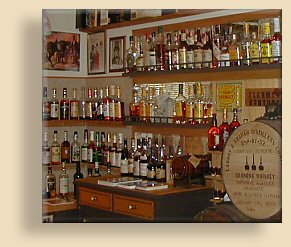 |
|
|
Story and original photography
© 2011 by John F. Lipman. All rights reserved. |
|
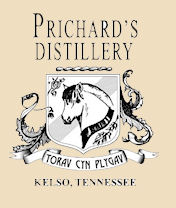 Prichard's
Distillery
Prichard's
Distillery
